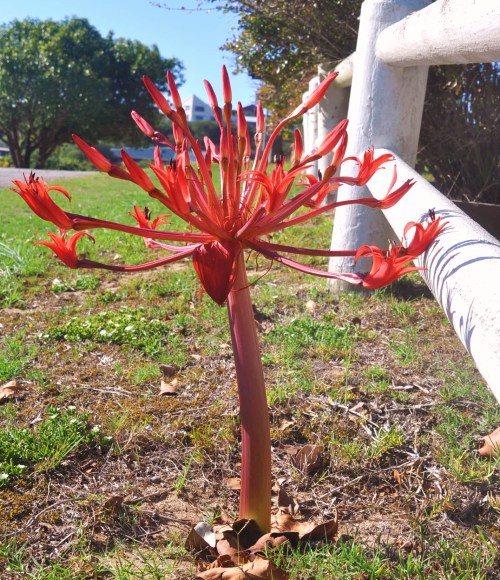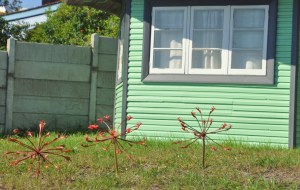The old cottage next door is hardly ever occupied and has no formal garden, but there is a short time in the year when I covet it. During March and April it becomes a field of Brunsvigia josephinae, named after Napoleon’s love and commonly called the candelabra lily.
These exceedingly strange looking Southern African plants occur in the winter rainfall regions of the western Karoo and Southern Cape. They are found usually on cooler and exposed slopes in sandy to clay soils, shale, limestone and weathered sandstone. They are able to withstand seasonal droughts and very low temperatures in the winter and are also resistant to veld fires.
The plants are deciduous and grow in winter. The leaves only appear in winter and rapidly die back in summer before the flowers are borne in late summer to autumn. The plants are pretty big, growing to about 0.65 m in height. The bulbs are usually exposed and covered with dry, papery tunics which are used by indigenous people as a wound dressing. Young Xhosa men use the tunics as plasters after circumcision.
The 30-40 flowers are carried on open, widely spreading shafts and are dark red. The flowers produce nectar, which is loved by the sunbirds. The seeds are ovoid, reddish green, fleshy and are dispersed when the capsule ruptures as it is blown by the wind. From seeds, plants may take up to 14 years to mature. Despite the long wait, I’ve taken some seeds from next door and planted them. I’ll update you in a decade or so.


What a wonderful, spunky plant! I can’t wait to see how yours develop. (What? You think I won’t be here? HA!)
I managed to get seed from my Cape Honeysuckle this year, and I’m going to try and cultivate them. How hard can it be? I suspect too much tenderness might be a problem with them, which makes them perfect for me. Many of our wildflowers are like that – and like your lily. They actually prefer poorer soil, and temperature and moisture extremes, provided they come at the right time.
We’ll see. At least I shouldn’t have to wait ten years to see the fruits of my labor!
Of course you’ll be here! I think you are right about too much tenderness. I thought of you yesterday as we drove through the local Kaaiman’s pass, the Cape Honeysuckle is berserk now, a sea of orange and red. The ones in my garden look good, but nothing like those on the side of road – with no compost and only rain water.
I have a friend who maintains the best way to rear children and turn them into successful adults is to treat them with benign neglect. Her kids thrive and I think that’s the way to treat our plants!
Those flowers! How unusual- in shape and color! Wow. A whole field of them would be remarkable, would make the person looking at the photo go” what? what am I looking at?”
These are remarkable. I love that they have a natural health application AND attract the birds.
Look forward to hearing your reports on growing them – surely you will have success! Yeah, it’s odd you’re readying for winter why we are lolling about with cabin fever. IT’s the kind of thing that makes me say big world, small world. It is. Both.
So great to hear from you. I’m catching up slowly with everyone.
Interesting take on child-rearing, and I suspect more right than current “experts” would prefer to acknowledge.
Here’s my childhood from age 6-10, a drama in one act.
(Screen door slams)
Me: “I’ll be back…”
Mother: “Don’t go too far…”
Me: “I won’t…”
(Screen door slams again)
Me: “I’m home…”
Mother: “Everything ok?”
Me: “Uh-huh…” (occasionally insert “Well, except for…”)
Mother: “Go get washed up…”
Now, that’s benign neglect. It didn’t hurt us at all.
On a completely different level, I suspect many of today’s hot-house children are so often ill and filled with allergies because they’re not allowed to build resistance. Eat enough dirt, share enough sandboxes with kitty-cats and wade in enough storm drains, and the germs flee YOU! 😉